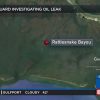
1. Build background on the 2010 Gulf of Mexico oil spill cleanup.
Distribute copies of the handout Oil Spills in Marine Environments for independent or small-group reading. Download and display the map Gulf of Mexico: A Geography of Offshore Oil from the October 2010 issue of National Geographic magazine. Describe for students the events that occurred on April 20, 2010. On the map, point out the location of the Macondo well—the site of the leak and the accidental destruction of the Deepwater Horizon drilling rig. Gesture to point out the loop current and explain how the oil has been distributed throughout these regions by currents, waves, winds, and tides.
2. Introduce the simulation.
Tell students that they will use a model to simulate an oil spill and its cleanup. Divide students into small groups of 3-6 students each. Have groups move to their assigned stations where materials are set out. Distribute copies of the worksheets Observations Before the Use of Dispersant and Observations After the Use of Dispersant to each group. Assign each member of the group a specific role—observer, data collector, and oil remover. Multiple students can have the same role in each group.
3. Explore the vocabulary.
Point out the definitions at the bottom of the handout Oil Spills in Marine Environments of types of equipment used to clean up oil spills: absorbers, booms, dispersants, and skimmers. Those same definitions can be found in the Background and Vocabulary tab of this activity. Ask students to observe the supplies they have available and discuss which supplies might represent each type of equipment used to clean up oil spills.
4. Have students simulate the oil spill.
Have students measure four tablespoons of vegetable oil and use a fork or a whisk to mix it with 1-4 drops of food coloring. Ask: What do you think the oil and food coloring represent? Explain to students that the oil represents crude oil and the food coloring represents chemicals trapped inside of the oil. Make sure they understand that the food coloring will not mix completely with the oil. Next, have students carefully pour the dyed oil into the center of the container with water and float a one-inch craft stick in the middle of the oil spill. Tell students that the craft stick represents a ship.
This is an excertpt from an article which can be found at source: National Geographic Society






